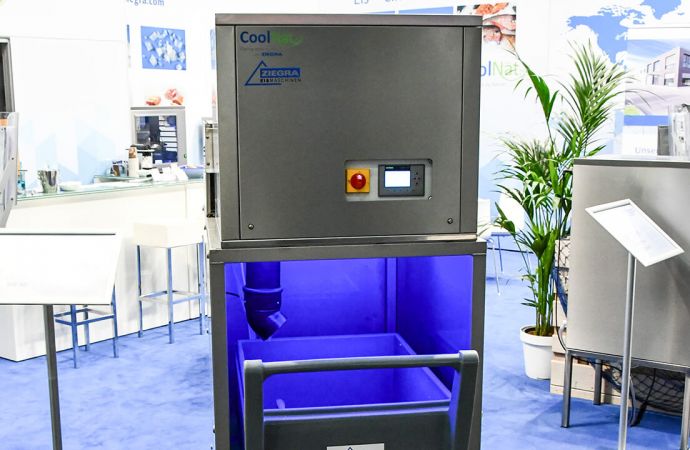This unit bridges the gap between a small-capacity ice maker using propane and a medium-capacity machine using CO2.

The new ice machine on display at Euroshop.
German manufacturer Ziegra has introduced an extension to its line of ice machines that uses CO2 in a small-capacity unit, filling a gap between its other models.
“This new ice machine builds a ‘bridge’ between the [very] small capacities using propane and the medium capacities using CO2, allowing us to switch completely to natural refrigerants,”said Silke Schael, Sales Director at Ziegra, in February at the EuroShop trade show in Düsseldorf, Germany, where Ziegra announced the product.
The new CoolNat ZBE 350 RA CO2 chip-type ice machine for small capacities uses German OEM Teko’s plug-n-play ROXSTRAmicro CO2 refrigeration unit, which was also launched at EuroShop. This PLC-controlled unit is extremely compact and uses two-stage compression, said Ziegra.
Propane is used for Ziegra’s small machines with an ice production capacity of up to 350kg (772lbs) per 24 hours, and a cooling capacity for the refrigeration unit of only 1.5kW (0.43TR), noted Schael. Anything bigger would require exceeding the current propane charge limit of 150g (0.33lbs) in a closed circuit. Until now, CO2 could be used for larger production capacities such as 15,000kg (33,069lbs).
However, with the ROXSTAmicro, Ziegra can now use CO2 for a smaller capacity, to produce a guaranteed 350kg (772lbs) of ice per day at a cooling capacity of 1.7kW (0.49TR). “This allows us to extend our offer of natural refrigerants, eventually leading to natural refrigerants for all capacities,” said Schael.
Another advantage of the new ice machine is that it is “self-sufficient,” meaning that the compact CO2 refrigeration unit can be placed directly at the ice machine. However, if required, a split installation at a distance of up to 20m (66ft) is also possible. In addition, energy is saved due to the exact frequency regulated refrigeration generation. The product can also be complemented by the “IcePort,” a solution for mobile ice storage.
Ziegra’s head office is in Isernhagen, close to Hanover, Germany, with branches in the U.K. and Spain. The company has been using CO2 as a refrigerant for 15 years, with many of its ice machines installed in supermarkets throughout Europe.
How does it work?
The working principle of an ice machine is that water is frozen inside the evaporator of the refrigeration unit and then broken into small pieces. There are two different types of flake ice based on temperature: chip-type and scale-type.
The chip-type flake ice, which is produced by the new CoolNat ZBE 350 RA CO2 machine, has a temperature of -0.5°C (31°F). It is a relatively humid ice, very easy to store, and moldable. It is often used to cool fish in supermarket counters, because, being moldable, it will not impact the structure of the fish. Besides, the temperature is relatively high, so the fish are not damaged by frost. Other applications are meat processing, dough cooling and saunas, and, it is also very suitable for laboratories, such as in hospitals or in research, for the cooling of samples.
On the other hand, scale-type flake ice is made at relatively low temperatures (-10°C to -5°C/ 14°F to 23°F) and is often used in meat processing facilities, because the cooling capacity is slightly higher than for chip-type flake ice.
Related stories



